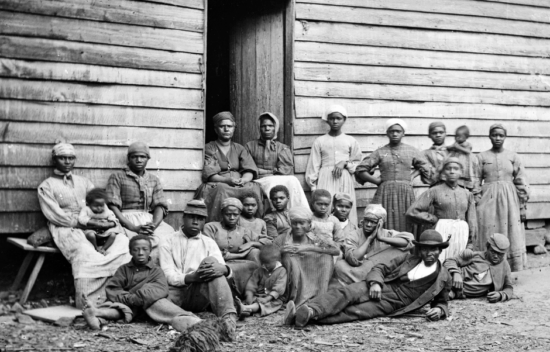
Underlying and Immediate Causes of the Civil War Timeline
Guiding Questions
- What were the underlying causes of the Civil War?
- How did slavery divide the nation?
Objectives
- Students will:
- Analyze the causes and effects of major conflicts and events leading up to the Civil War.
- Evaluate the effectiveness of political compromises and legislative actions.
- Interpret primary sources to understand historical perspectives.
Student Resources:
- America in Transition Interactive Timeline
- Civil War Interactive Timeline
- Countdown to War Graphic Organizer
Teacher Resources:
- Underlying and Immediate Causes of the Civil War Primary Source Set
- Long butcher paper, string, or another method to create a physical timeline across a classroom wall
Facilitation Notes
- This lesson explores the causes of the Civil War using two key resources: the America in Transition Interactive Timeline and the Civil War Interactive Timeline. These tools help students understand both the underlying tensions and immediate triggers that led to war.
- It is important to acknowledge that slavery is morally wrong and fundamentally violates natural rights and equality. Some of the perspectives presented in this lesson are historically accurate but controversial. They are included not to legitimize or justify these views, but to understand the full scope of beliefs that shaped the nation’s history. This historical examination allows students to critically engage with the past and recognize the importance of natural rights and equality.
Anticipate
Glossary term(s): compromise, tension, popular sovereignty, abolition, secession
Primary Source Speed Dating
- Arrange students in two circles (inner and outer). Each student gets a primary source card from one of the events.
- There are 15 primary source cards, so students will likely meet someone with the same source as them or talk to two people with the same source. Rather than let that be a concern, harness it as an example of how sources can be understood and interpreted differently or even incorrectly. Support students in listening to others skeptically, knowing that their peers are not experts on these sources, but are working to understand them too.
Teacher note: There are full-sized and half-sized pages of each source available in the Underlying and Immediate Causes of the Civil War Primary Source Set
- Give students 5-10 minutes to read their source and do any quick research they may need to answer the following questions:
- Who is the author, and what is their perspective?
- What event is this source reacting to?
- How does this source reflect growing tensions?
- Students have two to four minutes to explain their source to their partner before rotating using the questions as prompts.
- Ask students to not read their source aloud but describe and explain it to their partner at each turn.
- Students will likely recognize that they get better at explaining their source at each interaction.
- After several rotations, hold a debrief where students share the most powerful or surprising perspectives that they heard.
Scaffolding note: Be sure to “Stack the Deck.” Preview the primary source cards and plan a few difficult and a few simpler sources to assign to your learners that need challenge and support, respectively.
Engage
- Transition: Students return to their normal classroom seats, prepared for whole-group activity.
Timeline Creation
- Before class begins, create a wall timeline with four major sections:
- Missouri Compromise
- Compromise of 1850
- Kansas-Nebraska Act
- Secession
Teacher note: Flex the timeline format to fit your classroom. Clothes pins on a string, magnets on a whiteboard, or sticky tack on a blank wall all work well.
- Each student uses their card from the speed-dating activity to place their source on the classroom timeline.
- Place it on the class timeline in the correct area.
- Classify the primary source as primarily a Cause of the Civil War or Divisions over Slavery using color-coding.
- Use a color-coding system that works for your classroom, depending on the timeline method you chose.
- For example: If using a clothes pin timeline, you could have two different colored pins for students to use: Red for Causes of the Civil War and green for Divisions over Slavery.
- Add a sticky note explaining how the event or source affected tensions between the North and South OR how people living in the North and South might have responded to the source.
Explore
Interactive Timeline
Assign students to find and analyze the following events on the timeline:
- From the America in Transition Interactive Timeline:
- Missouri Compromise
- Compromise of 1850
- Kansas Nebraska Act
- Dred Scott Decision
- Lincoln Douglass Debate
- John Brown’s Raid on Harpers Ferry
- From the Civil War Interactive Timeline
- Lincoln’s Election
- South Secedes from the Union
- Students can informally view the timeline events for recording their thoughts and ideas at this stage or use the Interactive Timeline Notes Handout.
Graphic Organizer
- Students will complete a Countdown to War graphic organizer, mapping each major event leading to the Civil War.
- They will classify each event under: Attempt at Compromise, Escalation of Tensions, or Breaking Point.
Assess & Reflect
- Completed 3-2-1 Exit Ticket:
-
- 3 Key Events that Escalated Tension
- 2 Failed Compromises
- 1 Question They Still Have
AND/OR
- Written Response or Deconstructed DBQ:
- What were the underlying causes of the Civil War?
- Students can write a thesis, short written response, or complete a Deconstructed DBQ Graphic Organizer using the timeline and primary sources from the lesson.
Extend (Optional)
- Assign students to create a mini-documentary or podcast episode titled Countdown to Conflict summarizing their findings and reflections from the lesson.